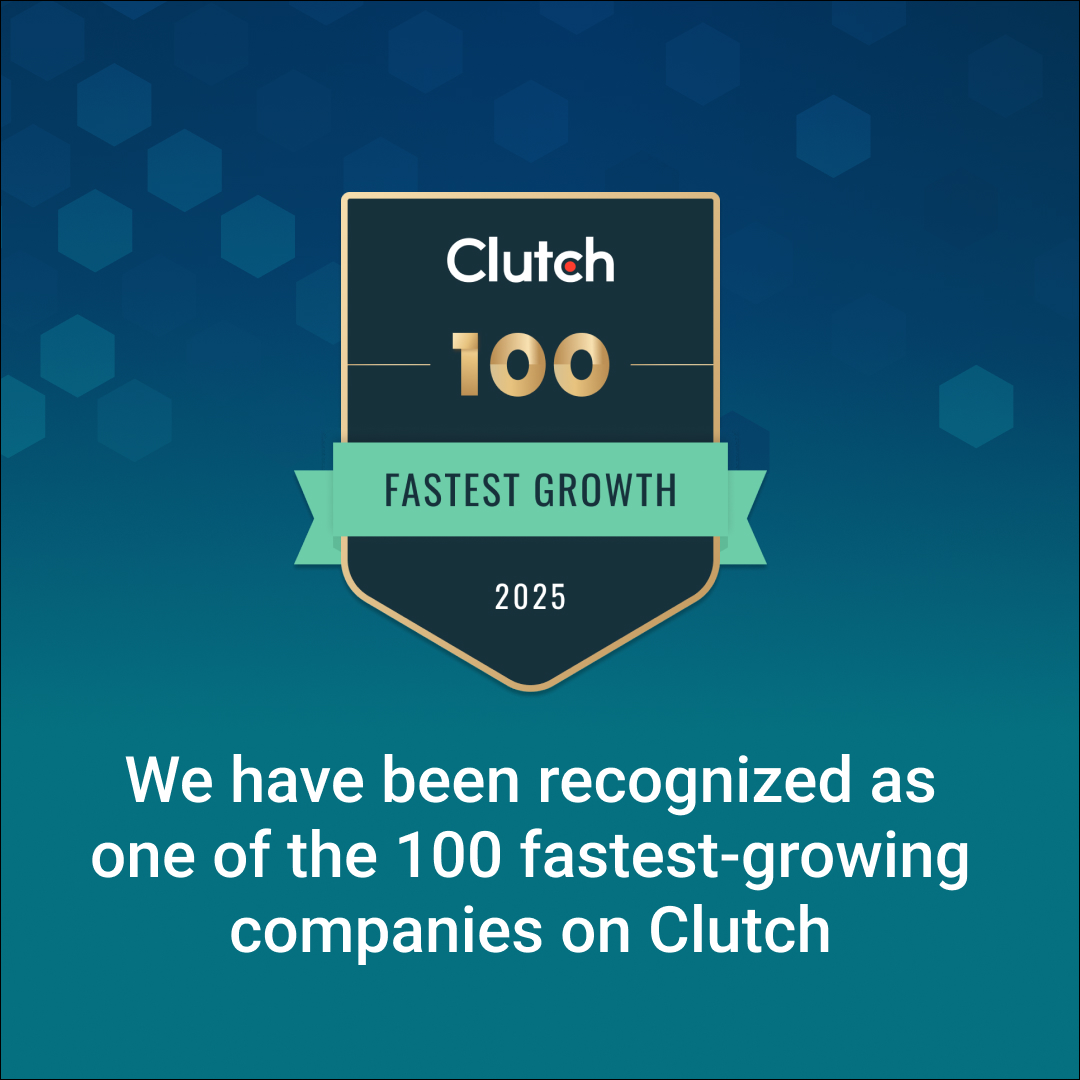Introduction

The Future Lies in AI-Blockchain Integration.
In today’s rapidly evolving technological landscape, two innovations stand out for their transformative potential: Artificial Intelligence (AI) and blockchain technology. Individually, each has significantly impacted various sectors, but their convergence is poised to revolutionize industries by enhancing security, efficiency, and transparency.
As you consider the convergence of AI and blockchain, it’s clear that real-world impact comes from thoughtfully engineered, production-ready solutions. To see how organizations are turning these innovations into measurable business value, explore our ai-powered software development services for practical strategies and proven results.
The Rise of AI and Blockchain
Over the past decade, AI has advanced remarkably, enabling machines to perform tasks that typically require human intelligence, such as learning, reasoning, and problem-solving. This progression has led to AI’s integration into numerous applications, from virtual assistants to sophisticated data analytics.
Concurrently, blockchain technology has emerged as a decentralized, distributed ledger system that ensures transparent and tamper-proof transactions. Its applications span from cryptocurrencies to supply chain management, offering solutions that prioritize security and trust.
Why AI and Blockchain Are a Game-Changing Combination
The integration of AI and blockchain creates a synergistic relationship where the strengths of one technology complement the other. Blockchain’s decentralized and secure data structures provide a reliable foundation for AI algorithms, enhancing data integrity and trustworthiness.
In return, AI can optimize blockchain operations by improving decision-making processes and automating complex tasks. This combination is particularly beneficial in sectors like finance, healthcare, and supply chain management, where both data security and intelligent analysis are paramount.
The Evolution of Technology Convergence
The convergence of AI and blockchain is part of a broader trend of integrating emerging technologies to create more robust and efficient systems. This evolution reflects a shift towards holistic solutions that leverage multiple technological advancements to address complex challenges.
By combining AI’s analytical capabilities with blockchain’s secure infrastructure, organizations can develop innovative applications that were previously unattainable, paving the way for a new era of technological progress.
Foundations of AI and Blockchain

Core Principles of AI and Blockchain.
To fully understand the potential of AI and blockchain, it is essential to delve into the basics of each technology and explore how they complement one another.
Understanding Artificial Intelligence: Basics and Key Concepts
Artificial Intelligence (AI) refers to the simulation of human intelligence processes by machines, particularly computer systems. These processes include learning, reasoning, and self-correction.
AI is categorized into three main types:
- Narrow AI: Focused on specific tasks, such as chatbots or recommendation systems.
- General AI: Hypothetical AI capable of performing any intellectual task humans can do.
- Superintelligent AI: An advanced stage of AI that surpasses human intelligence (still theoretical).
AI technologies such as machine learning, natural language processing, and computer vision are now integral to modern applications. By analyzing large datasets, AI enables decision-making, automation, and predictive analytics across industries.
Blockchain 101: Decentralized Ledgers and Beyond
Blockchain is a decentralized digital ledger that records transactions across multiple computers securely and transparently.
Key features of blockchain include:
- Decentralization: No single entity controls the system, enhancing trust and reducing the risk of fraud.
- Immutability: Once data is added to the blockchain, it cannot be altered, ensuring integrity.
- Transparency: Transactions are visible to all participants, fostering accountability.
Initially designed for cryptocurrencies like Bitcoin, blockchain has evolved to support use cases in supply chain management, healthcare, and financial services.
How AI and Blockchain Technologies Work Together
AI and blockchain are complementary technologies that enhance one another’s capabilities:
- Data Integrity for AI: Blockchain ensures that data fed into AI models is tamper-proof and reliable, addressing the issue of data bias or corruption.
- AI for Blockchain Optimization: AI can analyze blockchain data to identify patterns, predict trends, and enhance the performance of smart contracts.
- Secure AI Decision-Making: By leveraging blockchain, AI decisions become more transparent and auditable, increasing trust in AI systems.
The combination of AI and blockchain represents a powerful force for innovation, with each technology strengthening the other to address challenges across diverse sectors.
Synergies Between AI and Blockchain

AI and Blockchain Synergies.
The convergence of AI and blockchain offers remarkable potential by addressing each other’s limitations and enhancing their capabilities. Together, they drive greater security, efficiency, and innovation in applications across industries.
AI Solving Blockchain Challenges
Blockchain’s decentralized structure ensures transparency and security, but it is not without challenges, such as scalability, energy consumption, and data analysis. AI plays a pivotal role in overcoming these issues:
- Optimizing Scalability: AI algorithms can predict and manage transaction loads, improving blockchain’s ability to handle large volumes of data.
- Energy Efficiency: AI-powered systems optimize resource use in blockchain mining, reducing the high energy demands of processes like proof-of-work.
- Advanced Analytics: By analyzing large amounts of blockchain data, AI extracts meaningful insights, enabling businesses to detect patterns and make data-driven decisions.
Blockchain Enhancing AI Models
Blockchain addresses some of the critical challenges associated with AI models, such as data security, bias, and transparency:
- Data Integrity: Blockchain ensures that the data used to train AI models is tamper-proof, enhancing the reliability of predictions and insights.
- Auditable Decision-Making: Blockchain’s immutable ledger allows AI decisions to be traced back to their source data, ensuring transparency in critical applications like healthcare or finance.
- Decentralized Data Sharing: Blockchain enables secure, decentralized data sharing across organizations, giving AI access to richer datasets without compromising privacy (Forbes Tech Council).
Mutual Benefits: Security, Efficiency, and Innovation
The synergy between AI and blockchain creates mutual benefits that go beyond solving individual challenges:
- Enhanced Security: Blockchain secures AI processes by ensuring data provenance, while AI strengthens blockchain systems by detecting and mitigating cyber threats.
- Increased Efficiency: Together, they streamline operations, reducing costs and improving process efficiency across sectors like supply chain and logistics.
- Driving Innovation: The combination unlocks new applications, such as automated smart contracts, personalized healthcare solutions, and fraud detection in financial systems.
The collaboration between AI and blockchain is not merely about addressing challenges—it’s about unlocking a new wave of innovation. This partnership has the potential to redefine industries and set the stage for transformative change.
Technical Integration of AI and Blockchain

AI and Blockchain Integration Techniques.
The integration of AI and blockchain involves leveraging the unique capabilities of each technology to create powerful, innovative systems. Below are the key areas of technical integration and the challenges involved.
Using AI for Smart Contract Optimization
Smart contracts are self-executing agreements that run on blockchain, but their efficiency and functionality can be enhanced with AI:
- Automated Contract Analysis: AI-powered tools can analyze smart contract code to detect errors, vulnerabilities, and inefficiencies before deployment.
- Dynamic Smart Contracts: AI enables smart contracts to adapt to changing conditions in real time, making them more responsive and effective.
- Optimizing Gas Fees: AI algorithms can predict and optimize transaction costs (gas fees), making blockchain operations more cost-effective.
Decentralized AI Models on the Blockchain
Traditional AI systems rely on centralized servers for training and operation, which introduces risks such as data privacy breaches and single points of failure. By deploying AI models on blockchain, the following benefits can be realized:
- Decentralized AI Training: Blockchain allows multiple stakeholders to contribute to the training of AI models while maintaining data privacy and ownership.
- Incentive Mechanisms: Token-based systems on blockchain incentivize data sharing and collaboration for AI development.
- Improved Resilience: Decentralized AI systems are less prone to downtime and attacks, ensuring continuity and robustness.
Blockchain for Secure Data Sharing in AI Systems
Data is the lifeblood of AI systems, and blockchain enhances secure data sharing in several ways:
- Tamper-Proof Data: Blockchain ensures that data used in AI training and decision-making remains immutable and reliable.
- Privacy-Preserving Collaboration: Blockchain enables secure, encrypted data sharing between organizations without compromising privacy, fostering trust in data-driven partnerships.
- Regulatory Compliance: Blockchain-based systems facilitate compliance with data governance and privacy laws, such as GDPR.
Challenges in Integrating AI with Blockchain and How to Overcome Them
While the synergy between AI and blockchain is promising, integration presents several challenges:
- Scalability: Blockchain’s limited throughput can constrain AI’s real-time processing capabilities. Solution: Adopt advanced blockchain protocols, such as sharding or layer-2 scaling solutions, to improve transaction speeds.
- Energy Consumption: Blockchain systems, especially proof-of-work models, can be energy-intensive. Solution: Use energy-efficient consensus mechanisms like proof-of-stake or proof-of-authority.
- Complexity of Implementation: Integrating two advanced technologies requires expertise in both fields. Solution: Foster collaboration between AI and blockchain experts and develop user-friendly frameworks for implementation.
- Cost of Integration: High implementation costs can deter businesses from adopting AI-blockchain solutions. Solution: Leverage open-source platforms and scalable solutions to reduce costs.
The technical integration of AI and blockchain is both a challenge and an opportunity. By overcoming these hurdles, businesses can unlock the full potential of these technologies to drive innovation and efficiency across industries.
Applications of AI and Blockchain Across Industries
The convergence of AI and blockchain is reshaping industries, enabling innovative applications that drive efficiency, transparency, and enhanced user experiences. Below are key use cases in various sectors:
Healthcare: Revolutionizing Patient Records & Accelerating Drug Discovery with Blockchain and AI

Source: How Blockchain Can Revolutionize Healthcare Records Access & Security | Forbes
Blockchain ensures secure, tamper-proof storage of patient data, while AI analyzes these records to provide personalized treatment plans. This combination enhances interoperability across healthcare systems while maintaining data privacy and compliance.
In addition, AI models process massive datasets to identify potential drug candidates, and blockchain ensures transparency and data integrity throughout the research process. This synergy reduces the time and cost associated with drug development.
Finance: AI-Driven Fraud Detection Using Blockchain & Enhancing Transparent Transactions

Source: A Machine Learning and Blockchain Based Efficient Fraud Detection Mechanism | MDPI
AI identifies fraudulent patterns in financial transactions, while blockchain ensures the integrity of transactional data. This approach enhances security and trust in financial ecosystems.
Additionally, blockchain creates a transparent ledger for financial transactions, and AI automates compliance checks and reporting. This integration ensures accountability and reduces manual intervention in regulatory processes.
Supply Chain Management: Real-Time Tracking and Decision-Making
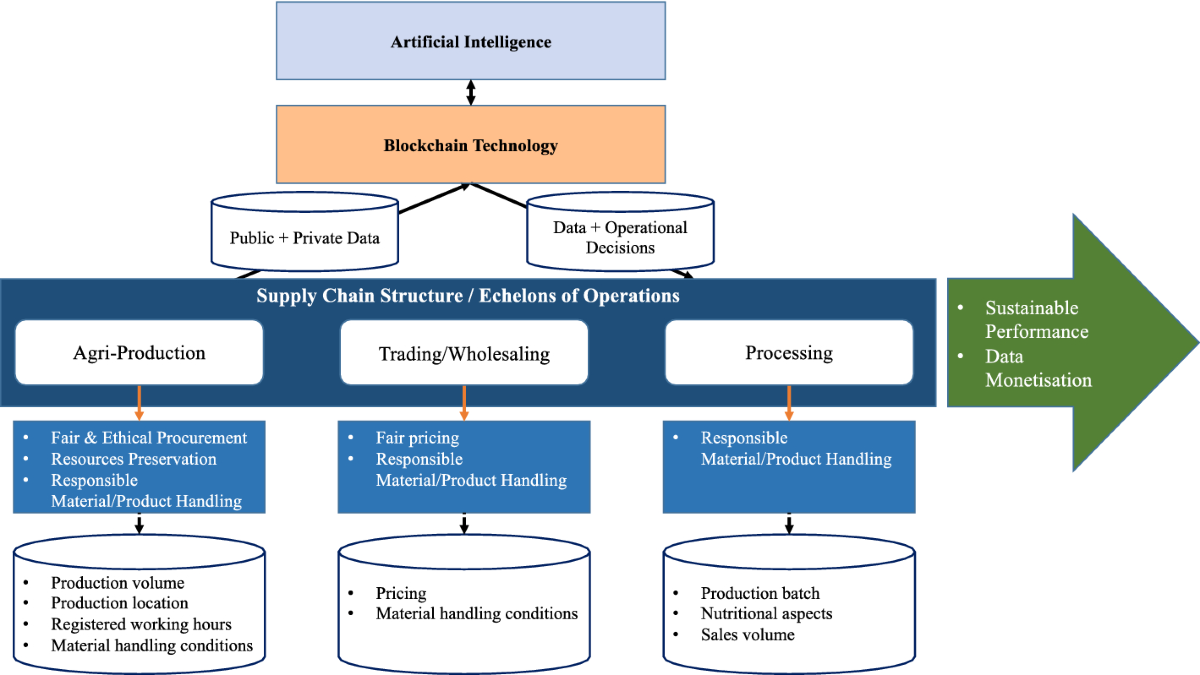
Source: Artificial intelligence and blockchain implementation in supply chains: a pathway to sustainability and data monetisation | link.springer.com
Blockchain provides a tamper-proof record of goods at every stage of the supply chain, while AI enables predictive analytics for demand forecasting and inventory management. Together, they enhance visibility, reduce delays, and optimize operations.
Gaming and Entertainment: AI for Immersive Experiences & Blockchain for Ownership

Source: AI-Powered Web3 Games Drive Blockchain Adoption in Gaming | GAM3S.GG
AI powers realistic characters, adaptive gameplay, and personalized user experiences in games. This creates richer and more engaging entertainment experiences.
Blockchain enables true ownership of digital assets like in-game items and NFTs, allowing players to trade or sell these assets securely. This fosters a new economy in the gaming and entertainment world.
Other Sectors
- Energy: AI optimizes energy consumption and forecasts demand, while blockchain facilitates peer-to-peer energy trading in decentralized grids.
- Real Estate: Blockchain enables secure property transactions, and AI streamlines processes like valuation and property management.
- Education: AI personalizes learning experiences, and blockchain secures academic records and certifications.
The applications of AI and blockchain span across industries, transforming traditional practices and creating new opportunities for innovation. Together, they represent the future of technological advancement, with the potential to redefine how industries operate globally.
Use Cases and Case Studies

What Opportunities Do AI and Blockchain Offer?
The integration of AI and blockchain has transitioned from theoretical possibilities to real-world applications, driving innovation across various sectors. Below are examples and case studies highlighting their potential.
Real-World Examples of AI and Blockchain Integration
- Healthcare: Personalized Treatment: A blockchain-based system ensures patient data integrity, while AI analyzes the data for tailored treatment plans. Case Study: IBM Watson Health and MediLedger use AI and blockchain to enhance data sharing and streamline operations in clinical trials (IBM Watson Health).
- Finance: Fraud Prevention: Blockchain records every transaction in an immutable ledger, and AI detects anomalies, reducing fraud risks. Case Study: PayPal integrates AI-driven fraud detection algorithms with blockchain technology to improve security.
- Supply Chain: Predictive Analytics: Blockchain ensures the authenticity of goods in transit, while AI predicts potential disruptions. Case Study: Walmart employs blockchain and AI to track and optimize its supply chain operations.
The Role of AI in Blockchain-Powered Decentralized Applications (dApps)
- Optimized Smart Contracts: AI automates the management of smart contracts in decentralized applications, improving efficiency and reducing errors. Example: Autonomous insurance dApps that use AI to process claims and blockchain to ensure transparency.
- Enhanced User Experiences: AI analyzes user behavior within dApps, offering personalized recommendations while blockchain ensures secure transactions. Example: Decentralized finance (DeFi) platforms that leverage AI for portfolio management and blockchain for trustless transactions.
How Blockchain Supports Responsible AI
- Ensuring Data Privacy: Blockchain secures user data, enabling AI systems to train and operate on anonymized datasets while maintaining privacy compliance. Case Study: Ocean Protocol allows AI developers to access decentralized datasets for training without compromising data privacy.
- Auditable AI Decisions: Blockchain creates a transparent, immutable record of AI decision-making processes, increasing accountability and addressing biases. Example: AI-based recruitment systems backed by blockchain ensure fair hiring practices and provide an audit trail of decisions.
- Decentralized AI Governance: Blockchain facilitates decentralized governance structures for AI, allowing stakeholders to participate in ethical AI development. Case Study: SingularityNET, a decentralized AI marketplace, uses blockchain to govern AI services responsibly.
By combining their strengths, AI and blockchain deliver innovative use cases that enhance efficiency, transparency, and security. These technologies are paving the way for a future where responsible AI operates seamlessly within decentralized systems, addressing real-world challenges and driving progress.
Ethical, Legal, and Regulatory Considerations

Addressing Ethical, Legal, and Regulatory Challenges in AI and Blockchain.
As AI and blockchain technologies continue to converge, their implementation raises important ethical, legal, and regulatory questions. Addressing these considerations is critical to fostering responsible innovation and ensuring public trust.
Ethics in AI and Blockchain
- Bias and Fairness in AI: AI systems can unintentionally reinforce biases present in training data. Blockchain can help mitigate this by providing transparent and immutable records of data sources, ensuring fairness in AI decision-making. Ethical AI frameworks emphasize accountability and inclusivity to minimize harm.
- Transparency and Accountability: Blockchain provides an immutable audit trail for AI algorithms and decisions, fostering transparency in applications like hiring and lending. Ensuring that AI and blockchain systems remain explainable and auditable is essential for ethical use.
- Digital Trust: Blockchain ensures secure and tamper-proof data storage, while AI analyzes data responsibly. Together, they build trust in applications like smart contracts and identity verification.
Data Privacy and Ownership
- User-Centric Privacy: Blockchain ensures that users retain ownership of their data, allowing them to grant or revoke access securely. Example: Decentralized data-sharing platforms like Ocean Protocol enable individuals to monetize their data without losing ownership or privacy.
- AI’s Need for Large Datasets: AI systems require vast amounts of data for training and optimization. Blockchain facilitates secure data sharing across stakeholders without compromising privacy.
- Cross-Border Data Transfers: Blockchain’s decentralized nature supports secure cross-border data transfers, addressing privacy concerns in international AI applications. Example: Platforms like Algorand prioritize compliance with global data regulations to ensure secure and legal data exchange.
Navigating the Global Regulatory Landscape
- Divergent Regulations: Regulatory frameworks for AI and blockchain vary significantly across regions. For instance: The EU emphasizes ethical AI and privacy (e.g., GDPR and the AI Act). The US focuses on fostering innovation with less restrictive regulations. The Asia-Pacific region is a mix of stringent and flexible approaches depending on the country.
- Challenges in Harmonization: Blockchain’s decentralized nature often conflicts with existing regulatory structures that require centralized oversight. AI applications must comply with sector-specific regulations, such as healthcare or finance laws, which differ globally.
- Proactive Governance: Governments and organizations must establish proactive policies to encourage innovation while addressing risks. Example: The OECD AI Principles emphasize transparency, accountability, and human-centric AI.
The ethical, legal, and regulatory challenges surrounding AI and blockchain are complex but essential to address. By focusing on transparency, privacy, and compliance, these technologies can be implemented responsibly, fostering trust and driving sustainable innovation.
Future Trends in AI and Blockchain
As the integration of AI and blockchain continues to evolve, several groundbreaking trends are set to shape the future of technology. These trends highlight the potential for decentralized systems, new internet paradigms, and emerging technologies.
Decentralized AI Models: The Next Big Thing

Source: Decentralized AI: The future of AI development, the power and necessity | Iceclog
- What Decentralized AI Models Are: Decentralized AI models leverage blockchain networks to distribute AI training and inference across nodes. This removes reliance on centralized systems, ensuring data privacy and system resilience.
- Key Benefits:Decentralized models enable users to train AI locally, ensuring the protection of sensitive data, while blockchain facilitates collaborative AI development by incentivizing data sharing through tokenization, driving accelerated innovation.
- Examples: Platforms like SingularityNET provide marketplaces for decentralized AI services, enabling broader accessibility and governance.
Predicting the Role of AI and Blockchain in Web3
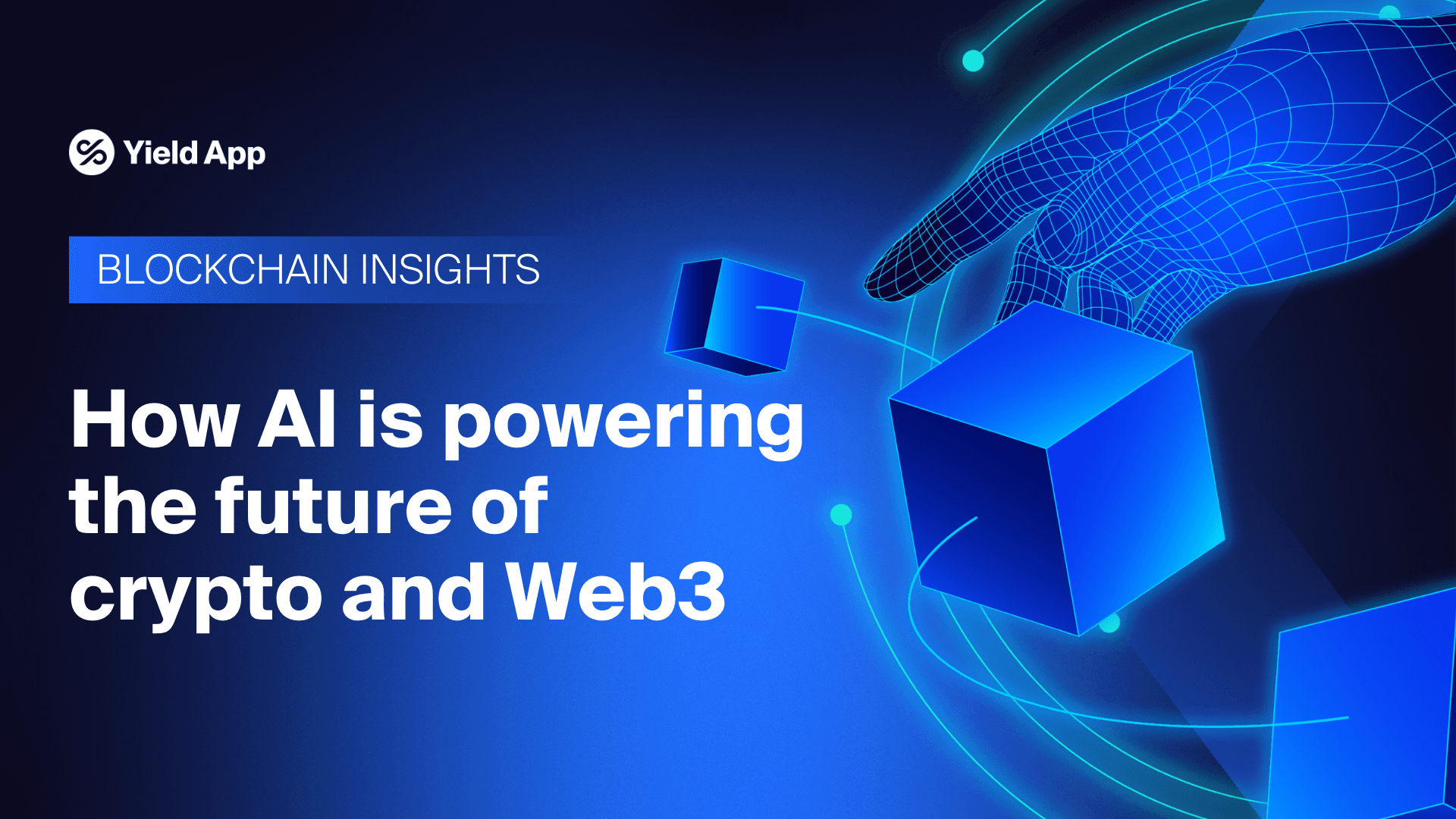
Source: AI meets blockchain: Powering the future of crypto and Web3 | Yield App
- AI as the Intelligence Layer of Web3: In the decentralized Web3 ecosystem, AI will play a critical role in automating processes, such as content moderation, personalized user experiences, and DeFi (Decentralized Finance) portfolio management.
- Blockchain as the Trust Layer of Web3: Blockchain ensures the transparency and security of transactions, smart contracts, and digital asset ownership in Web3.
- Synergies in Web3: AI and blockchain together can enable decentralized autonomous organizations (DAOs) that are both self-governing and highly efficient. For example: AI-driven DAOs can predict market trends and execute blockchain-based transactions autonomously.
The Role of Quantum Computing in AI and Blockchain

Source: Mixing Quantum Computing, Blockchain and AI | Tatiana Revoredo Medium
- Quantum Computing in AI: Quantum computing has the potential to exponentially speed up AI algorithms, making tasks like natural language processing and deep learning more efficient. However, this also poses risks, as quantum computing could disrupt AI models designed for classical computing.
- Quantum Computing in Blockchain: Blockchain’s encryption methods could become vulnerable to quantum attacks. To address this, research into quantum-resistant cryptography is underway. Blockchain networks will also benefit from quantum-powered consensus mechanisms, enabling faster and more efficient transaction validation.
- The Intersection of AI, Blockchain, and Quantum Computing: Quantum computing could enable large-scale training of decentralized AI models while enhancing blockchain scalability. This triad of technologies is expected to drive the next wave of innovation in areas like secure multiparty computation and ultra-efficient supply chains.
The future of AI and blockchain is poised to be transformative, particularly as decentralized systems, Web3, and quantum computing converge. These trends not only promise to solve existing challenges but also open doors to new opportunities across industries, setting the stage for a more interconnected, intelligent, and secure digital landscape.
Challenges and Limitations of AI and Blockchain Integration
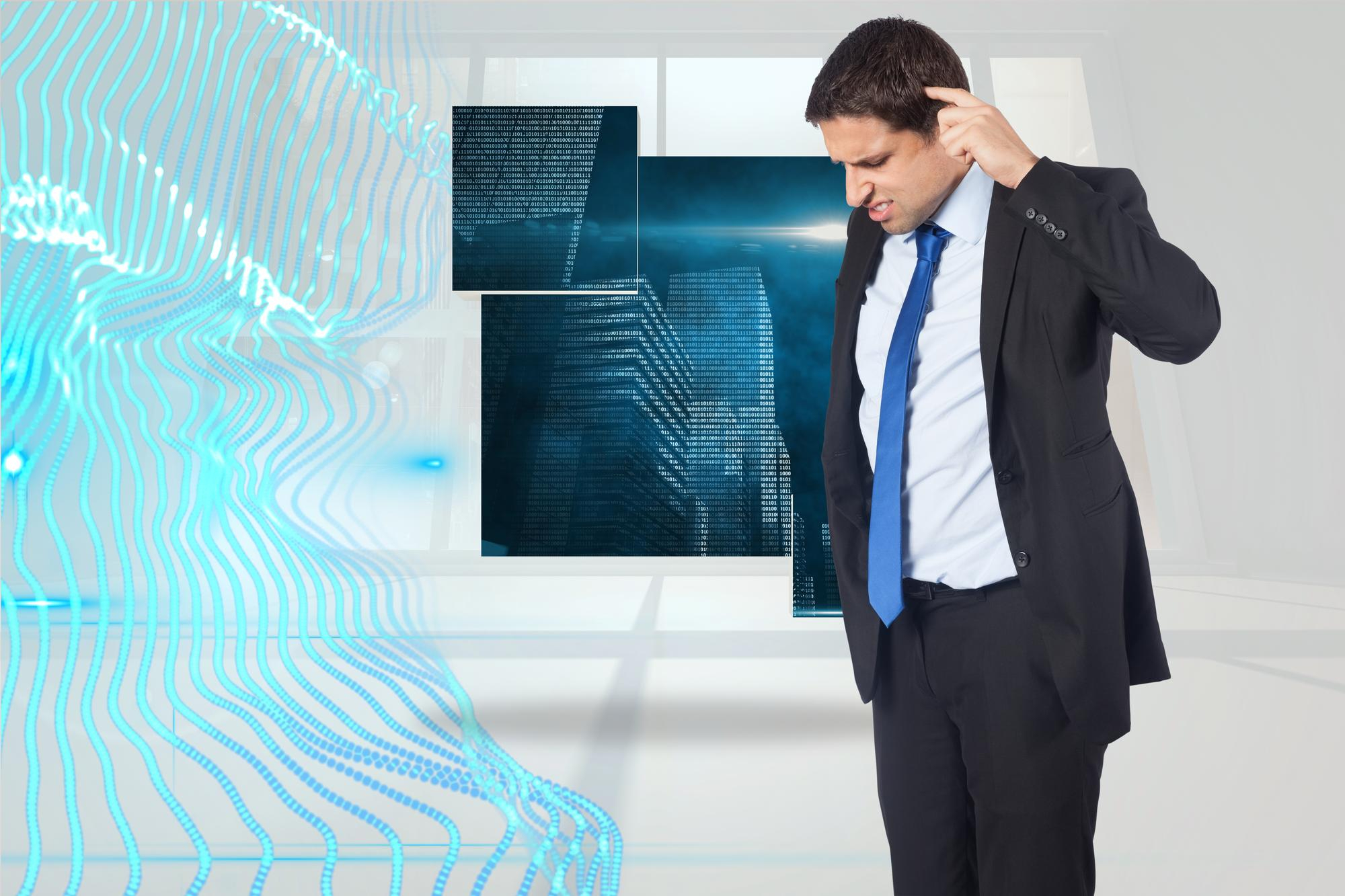
Addressing Technical Challenges and Limitations in AI-Blockchain Integration.
While the integration of AI and blockchain offers immense potential, it also faces significant challenges that need to be addressed for widespread adoption. Below are the key limitations and strategies to overcome them.
Addressing Scalability Issues
- Blockchain’s Scalability Bottleneck: Current blockchain networks, particularly those using proof-of-work (PoW) mechanisms, face limitations in transaction speed and throughput. These bottlenecks can hinder real-time AI applications that require high-frequency data processing.
- AI’s Demand for Large Datasets: AI systems require vast amounts of data to function effectively. Storing and processing such datasets on blockchain can strain the system’s capacity and increase latency.
- Solutions: To enhance blockchain performance, implement Layer-2 scaling solutions, such as rollups or sidechains, to manage high transaction volumes without overwhelming the main blockchain. Transition to efficient consensus mechanisms like proof-of-stake (PoS) or proof-of-authority (PoA), as demonstrated by Ethereum’s PoS upgrade, to boost transaction speeds and energy efficiency. Additionally, integrate edge computing to offload data processing to edge devices, alleviating network strain.
Tackling the Lack of Standardization
- Fragmentation Across Platforms: Different blockchain networks and AI frameworks operate with unique protocols, tools, and configurations. This lack of standardization complicates interoperability between systems.
- Challenges in Data Integration: The absence of uniform data formats and governance policies makes it difficult to integrate datasets across different AI-blockchain ecosystems.
- Solutions: To enable seamless integration of blockchain and AI, establish global standards through organizations like ISO and IEEE, which are developing standardized protocols (e.g., ISO Blockchain Standards). Encourage open-source collaboration to foster the adoption of shared frameworks, simplifying interoperability. Additionally, leverage middleware solutions to act as an interface layer, bridging gaps between otherwise incompatible systems.
Bridging the Skill Gap
- Shortage of Skilled Professionals: The intersection of AI and blockchain requires expertise in both domains, but professionals proficient in these fields are scarce.
- Challenges in Workforce Development: Rapid technological advancements outpace the rate at which professionals can acquire the necessary skills, leading to a talent gap in AI-blockchain integration projects.
- Solutions: To build a skilled workforce for AI and blockchain integration, develop specialized training programs through universities and online platforms, focusing on this emerging field. Foster industry partnerships to provide hands-on training and real-world exposure through collaboration between academia and businesses. Additionally, encourage employers to implement upskilling initiatives, enabling existing employees to bridge the skill gap and stay competitive.
While these challenges pose significant hurdles, they also present opportunities for innovation and collaboration. By addressing issues related to scalability, standardization, and skill development, AI and blockchain can unlock their full potential and drive transformative change across industries.
Tools, Platforms, and Frameworks for AI and Blockchain Integration
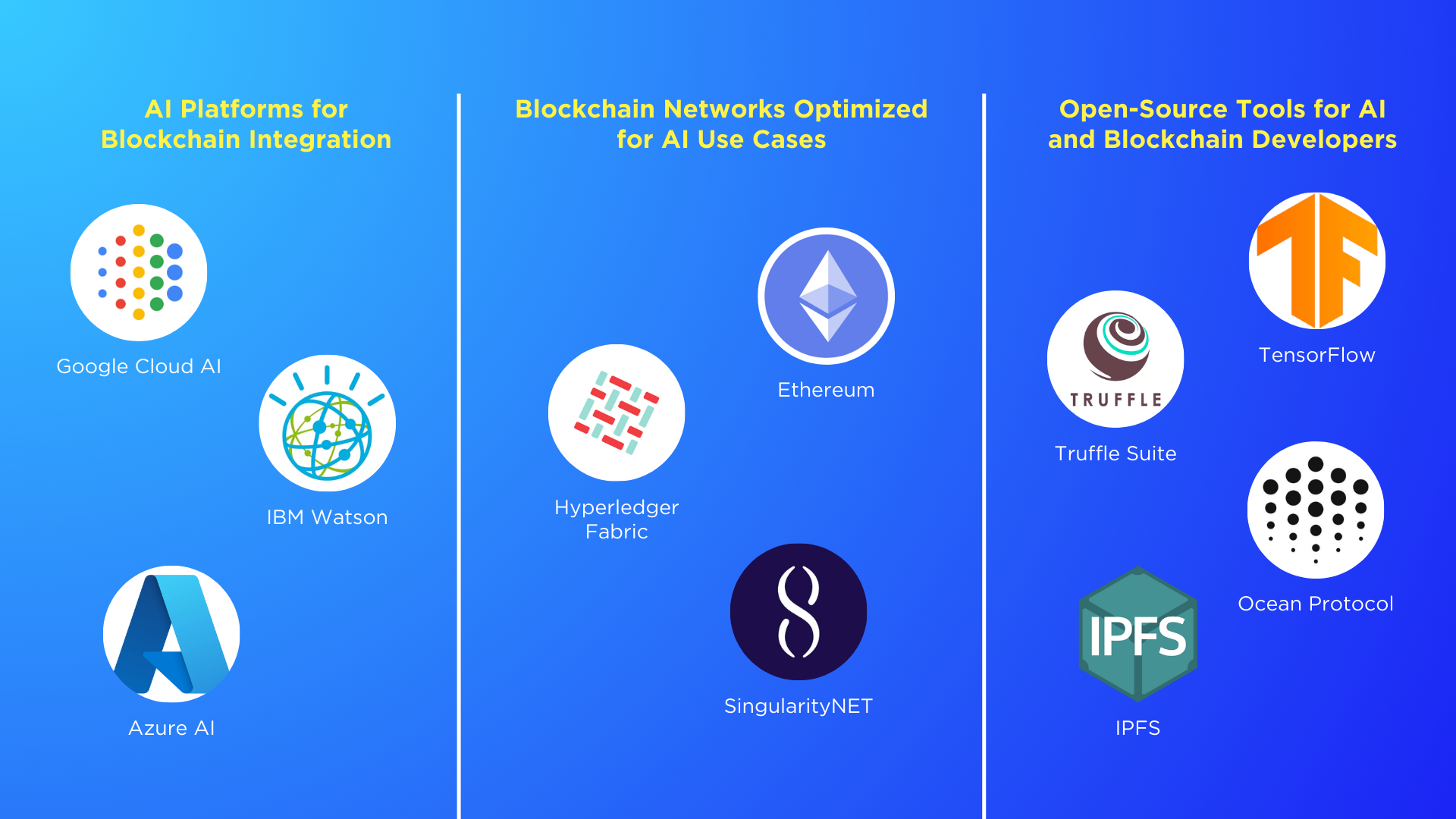
Essential Tools and Frameworks for AI-Blockchain Integration.
As AI and blockchain technologies converge, various tools, platforms, and frameworks are emerging to facilitate their integration. These resources empower developers and organizations to build innovative applications and solutions.
AI Platforms for Blockchain Integration
- Google Cloud AI: Offers pre-trained machine learning models and tools that can be integrated with blockchain systems for enhanced data analysis and automation. Features: Scalable AI services, data analytics, and real-time processing. Use Case: AI models for blockchain-based predictive analytics.
- IBM Watson: Provides robust AI solutions for natural language processing, automation, and decision-making, which can be combined with blockchain for secure and transparent workflows. Use Case: Healthcare systems using Watson AI with blockchain for patient data management.
- Azure AI: A platform that integrates seamlessly with Microsoft’s blockchain offerings, enabling developers to build AI-powered decentralized applications. Features: Scalable AI services, customizable tools for developers, and blockchain integration support.
Blockchain Networks Optimized for AI Use Cases
- Ethereum: A widely used blockchain network known for its smart contract capabilities, making it suitable for decentralized AI applications. Features: Large developer community, support for tokenization, and integration with AI-powered dApps.
- Hyperledger Fabric: A permissioned blockchain framework ideal for enterprise use cases requiring private and secure AI implementations. Use Case: Supply chain solutions with AI-based analytics integrated into Hyperledger’s blockchain network.
- SingularityNET: A decentralized AI marketplace built on blockchain that allows developers to create, share, and monetize AI services. Features: Token-based incentives and a platform tailored for decentralized AI models.
Open-Source Tools for AI and Blockchain Developers
- TensorFlow: An open-source machine learning framework widely used for building and training AI models that can be integrated into blockchain ecosystems. Use Case: Training AI models for blockchain-based fraud detection.
- Truffle Suite: A development framework for Ethereum that simplifies the creation and deployment of AI-powered smart contracts. Features: Testing tools, a development environment, and blockchain debugging.
- Ocean Protocol: An open-source platform that facilitates secure and decentralized data sharing for AI applications. Use Case: Sharing anonymized datasets for AI training while maintaining data ownership on the blockchain.
- IPFS (InterPlanetary File System): A decentralized storage system ideal for securely storing and accessing large datasets used in AI applications. Features: Data immutability, high availability, and integration with blockchain networks.
The availability of these tools, platforms, and frameworks makes it easier for developers and organizations to leverage the combined power of AI and blockchain. By choosing the right resources, they can build applications that are innovative, efficient, and secure, paving the way for future advancements.
How to Get Started with AI and Blockchain
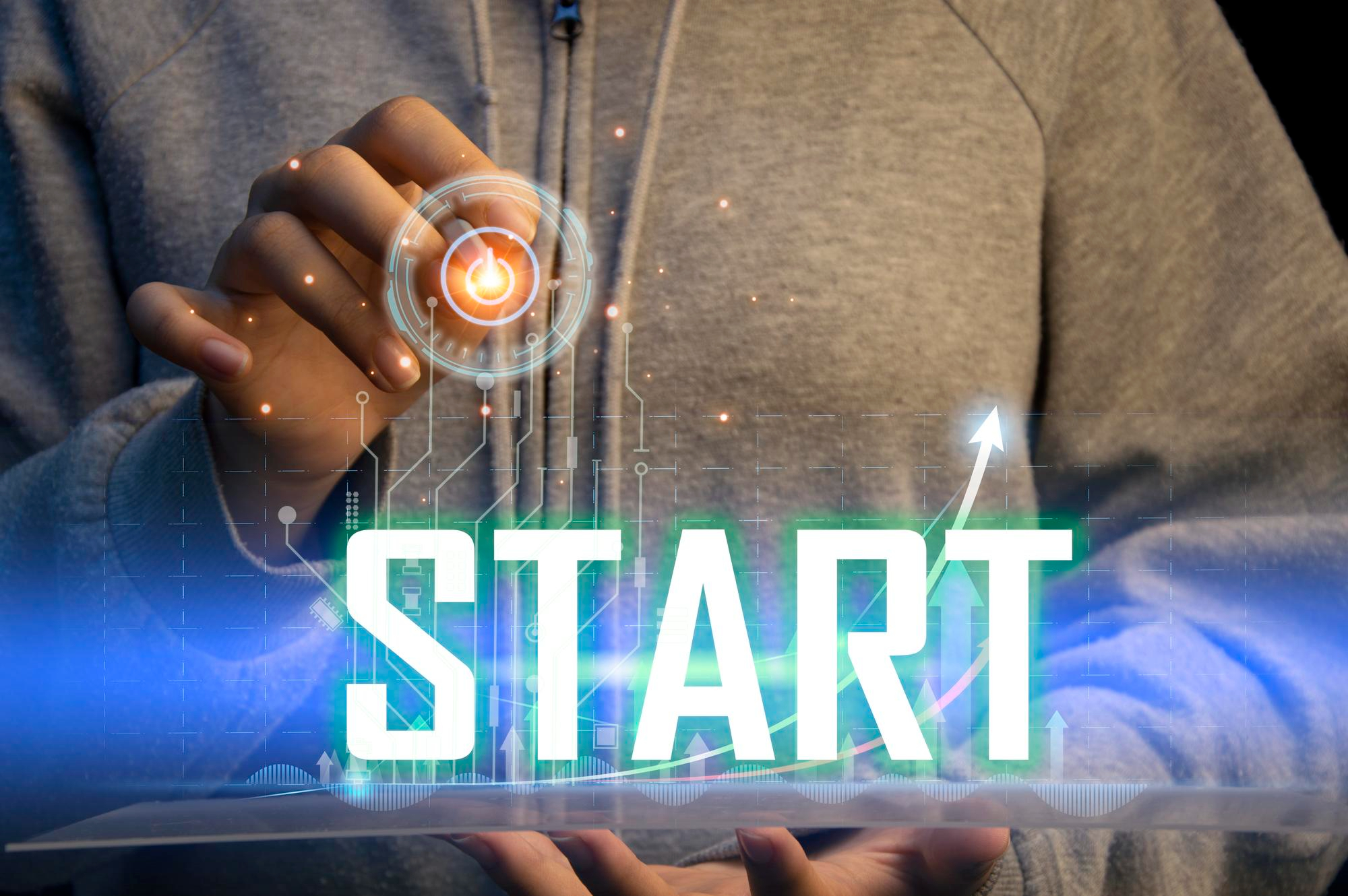
Prepare to Get Started with AI and Blockchain!
Integrating AI and blockchain technologies can seem daunting at first, but with the right approach and resources, you can successfully embark on this innovative journey. Below are steps and tips to help you get started.
Building Your First Blockchain-AI Solution
- Identify a Use Case: Begin by identifying a practical use case where AI and blockchain integration can create value, such as fraud detection in finance, real-time tracking in supply chain management, or secure data sharing in healthcare.
- Choose the Right Tools and Platforms: Utilize frameworks like TensorFlow or PyTorch to develop and train AI models, and integrate them with blockchain networks such as Ethereum for smart contracts or Hyperledger Fabric for enterprise-grade solutions.
- Develop and Test Your Solution: Develop the AI model by training it with high-quality datasets, then integrate it with blockchain technology using smart contracts to ensure secure execution and tamper-proof recording. Conduct thorough testing to validate scalability, security, and efficiency.
- Deploy and Monitor: Once the solution is tested, deploy it on your chosen blockchain network. Monitor performance and iterate for improvements.
Partnering with AI and Blockchain Experts (SmartDev)
- Why Partner with Experts: Partnering with experienced developers and consultants accelerates the development process and ensures best practices are followed. Companies like SmartDev specialize in custom AI-blockchain solutions, offering expertise in system design, development, and deployment.
- What to Look for in a Partner: Proven experience in both AI and blockchain. A strong portfolio of successful projects. Support for end-to-end implementation, from ideation to maintenance.
- Collaborating Effectively: Clearly communicate your goals and requirements. Work closely with the team during development to align the solution with your vision.
Key Resources for Beginners
- Online Courses and Tutorials: Platforms like Coursera, with courses such as ‘AI for Everyone’ and ‘Blockchain Basics,’ provide foundational knowledge, while Udemy complements this with hands-on courses focused on AI, blockchain, and their integration.
- Open-Source Communities: Engage with developer communities on platforms like GitHub, Reddit, or Stack Overflow to learn from experts and access pre-built templates. Enhance your skills further by contributing to open-source projects for hands-on experience.
- Books and Research Papers: Start with Blockchain Basics by Daniel Drescher for a clear introduction to blockchain technology, and explore Artificial Intelligence: A Guide to Intelligent Systems by Michael Negnevitsky for an in-depth understanding of AI concepts.
- Developer Documentation: Refer to official documentation for platforms like Ethereum, Hyperledger, TensorFlow, and PyTorch for technical guidance.
Starting with AI and blockchain requires a combination of foundational knowledge, the right tools, and guidance from experienced professionals. By following these steps and leveraging available resources, you can successfully develop innovative solutions that harness the power of these transformative technologies.
Conclusion
As industries evolve in the face of rapid technological advancements, the integration of cutting-edge solutions becomes essential for staying competitive. Among these, AI and blockchain stand out as transformative forces driving innovation and progress.
The Transformative Power of AI and Blockchain
The integration of AI and blockchain represents a monumental shift in how industries operate, unlocking new possibilities for innovation, efficiency, and transparency. Together, these technologies create a synergy where blockchain provides a secure and decentralized foundation, while AI adds intelligence and analytical capabilities. From revolutionizing healthcare and finance to enhancing supply chain management and gaming, the impact of this convergence is already evident.
By addressing challenges such as scalability, standardization, and the skill gap, organizations can fully leverage the potential of AI and blockchain. The tools, platforms, and frameworks available today make it easier than ever to explore this powerful partnership.
Preparing for the Future
As we look ahead, the role of AI and blockchain will only expand, with trends like decentralized AI models, Web3 integration, and quantum computing reshaping the technological landscape. To stay competitive, businesses must proactively invest in research, talent development, and strategic collaborations.
The journey may be challenging, but the rewards are immense. Organizations that embrace this transformative combination will not only enhance their operations but also drive innovation that benefits society as a whole.
AI and blockchain are more than just technologies—they are the foundation of the next era of digital transformation. Now is the time to prepare for the future and harness their full potential.
—-


